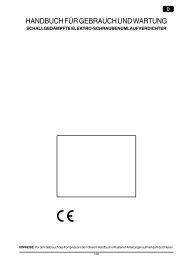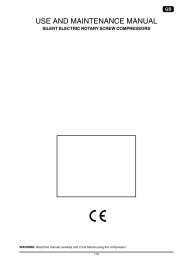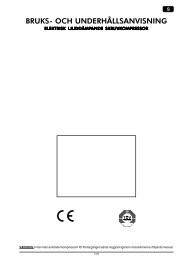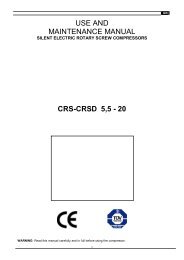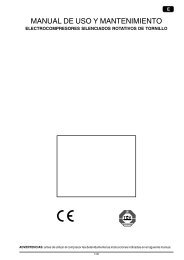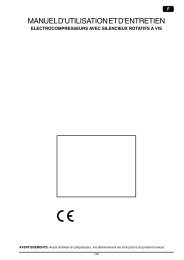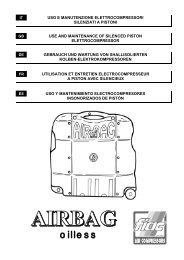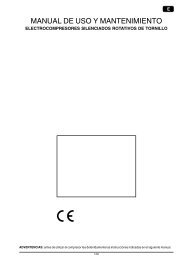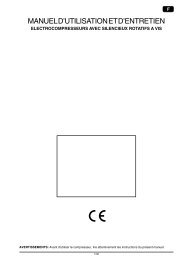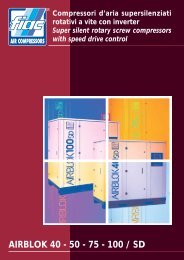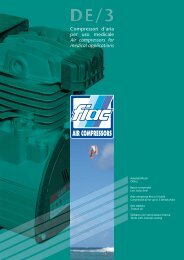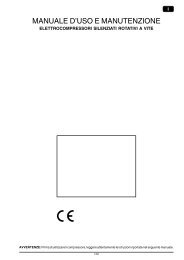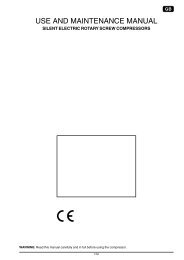GB20ELEC<strong>TR</strong>ICAL CONNECTIONSingle-phase compressors are supplied with an electrical cable and atwo-pole + earth plug. The compressor must be connected to a groundedpower socket (fig.12).Three-phase compressors (L1+L2+L3+PE) must be installed by aspecialised technician. Three-phase compressors are supplied withouta plug. Connect a plug, with screw-on grommet and securing collar(fig.13), to the cable, consulting the table below.HP kW Power supply volt/ph Plug model2 – 3 – 4 1.5 – 2.2 – 3 220/380/3230/400/3 16A 3 pole + ground5.5 – 7.5 – 10 4 – 5.5 – 7.5 220/380/3230/400/3 32A 3 pole + groundNOTE: Compressors installed on the 500 lt tank, with capacity of HP7.5/55 kW and HP10/7.5 kW can be supplied a star/triangle starting controlunit, whereas the TANDEM (n. 2 pumping elements on the same tank)are supplied with a timed control unit for staggered starting of the twopumping elements.Installation instructions:– Secure the control unit box on a wall or on a fixed support, and provideit with a power cable with plug, of a diameter in proportion to itslength.– Any damage caused by incorrect connections of the power line tothe mains, automatically excludes warranty of electrical parts. To avoidconnection errors, we advise you to contact a specialised technician.IMPORTANT:Never use the ground socket instead of the neutral wire. The groundconnection must be made to meet safety standards(EN 60204).The plug of the power cable must not be used as a switch, but must befitted in a power socket controlled by a suitable differential switch (thermalbreaker).STARTINGCheck that the mains power matches that indicated on the electricaldata-plate (fig.14) – the permissible tolerance range is +/-5%. Whenfirst starting compressors operating on 3-phase voltage, check therotation direction of the cooling fan by comparing it with the direction ofthe arrow on the belt guard or on the protective housing. In the SILENTcompressor, check if the air flows is in the direction illustrated in fig.21A.Turn or press into position “0” (according to the type of pressure switchfitted on the appliance) the knob located on the upper section (fig. 15).Fit the plug in the power socket (fig. 12 - 13) and start the compressor,turning the pressure switch knob into position “I”. The compressor isfully automatic, and is controlled by the pressure switch which stops itwhen tank pressure reaches maximum value and restarts it when it fallsto minimum value. The pressure difference between maximum andminimum values is usually about 2 bar (29 psi).E.g.: the compressor stops when it reaches 8 bar (116 psi – maximumoperating pressure) and restarts automatically when the pressure insidethe tank drops to 6 bar (87 psi).After connecting the compressor to the power line, load it to maximumpressure and check exactly how the machine is operating.COMPRESSORS WITH D STARTINGCON<strong>TR</strong>OL UNIT (fig. 16)Fit the plug in the power socket (fig. 13) and turn the pressure switch toposition “I” (ON) (fig. 17). Turn the master power switch “A” on the controlunit to position I – power On is signalled by white indicator-light “E”going on. Turn switch “B” to position 1 to start the compressor. If theYsolenoid-valve indicator-light “D” and the motor (C) indicator-light (C) goon in that order, this means the machine is operating perfectly (fig. 18).TANDEM COMPRESSORS WITH TIMEDCON<strong>TR</strong>OL UNIT (fig. 17)Fit the plug in the power socket (fig. 13) and turn the pressure switch toposition “I” (ON). Turn the master power switch “A” on the control unit toposition I – power On is signalled by white indicator-light “E” going on.Turn switch “B” to start the compressor.Pos. 1 pumping element n. 1 only is operatingPos. 2 pumping element n. 2 only is operatingPos. 3 both pumping elements are operating simultaneously, at staggeredstarting times.The compressor is fully automatic, and is controlled by the pressureswitch which stops it when tank pressure reaches maximum value andrestarts it when it falls to minimum value.NOTE: The head/cylinder/delivery tube unit can reachhigh temperatures. Take care when working near these parts, and donot touch them to avoid possible burns (fig. 18 - 19).IMPORTANTThe electro-compressors must be connected to a power socket protectedby a suitable differential switch (thermal-breaker). The motor of <strong>GM</strong>-<strong>TR</strong>compressors is equipped with an automatic thermal breaker locatedinside the winding – this stops the compressor when motor temperaturereaches excessively high values.If the breaker is tripped, the compressors restarts automatically after10 to 15 minutes. The motors of compressor models <strong>VX</strong> are suppliedwith a manually resetting automatic amperometric thermal-breaker,located outside the terminal board cover.When the breaker is tripped, wait for a few minutes and then reset thebreaker manually (fig. 20).The motors of the <strong>AB</strong> series compressors are supplied with a manuallyresetting amperometric thermal-breaker, located on the terminal boardcover. When the breaker is tripped, wait for a few minutes and thenreset the breaker manually (fig. 20).The safety davice is automatic in three-phase and silent compressors.When the thermal-breaker is tripped, the pressure switch is released to“0” (OFF) position.Wait for a few minutes and return the pressure switch to “I” (ON) position(with the exception of models: <strong>AB</strong> 100/245-335 Three-phase - <strong>AB</strong> 150/245-335 Three-phase - <strong>AB</strong> 200/245-335 Three-phase). Forcompressors supplied with a control unit, the thermal-breaker is installedinside the control unit. When the thermal-breaker is tripped, observethe following procedure (fig. 22):• Turn the switches on the control unit cover to position “0”, open thecover and press push-button 1 of the thermal-breaker. Close thecover of the control unit and restart the compressor, observing theoperations described in the paragraph “Starting compressors withcontrol unit”.The same instructions apply to compressors powered at 60 Hz.ADJUSTING OPERATING PRESSURE (fig. 23)You do not have to use the maximum operating pressure at all times. Onthe contrary, the pneumatic tool being used often requires less pressure.On compressors supplied with a pressure reducer, operating pressuremust be correctly adjusted.Release the pressure reducer knob by pulling it up, adjust pressure tothe required value by turning the knob clockwise to increase pressureand anti-clockwise to reduce it. When you have obtained optimumpressure, lock the knob by pressing it downward (fig. 23). For pressurereducers equipped without a pressure gauge, the set pressure can beseen on the graduated scale located on the reducer body.
21 GBOn pressure reducers equipped with a pressure gauge, pressure canbe seen on the gauge itself.WARNING: Some pressure regulators do not have "push to lock",therefore simply turn the knob to adjust the pressure.MAINTENANCEBefore attempting any maintenance jobs on the compressor, make sureof the following:– Master power switch in position “0”.– Pressure switch and the control unit switches all off, in position “0”.– No pressure in the air tank.Every 50 hours of duty: we advise you to dismantle the suction filter andclean the filtering element by blowing compressed air on it (fig. 24).You are recommended to replace the filter element at least once if thecompressor operates in a clean environment, but more frequently if in adusty environment.In the “red-head” models (fig. 25) (<strong>TR</strong>200 – <strong>TR</strong>255), the suction filter islocated internally under the conveying cover (read-head). Unscrew thethree cover securing screws, remove the cover from the guard joint,remove the filter from its seat, and begin cleaning, blowing compressedair in opposite to normal flow direction.In the Silent model, the filtering element can be replaced by taking offthe soundproofing cabinet and proceeding in the same way as for the<strong>AB</strong> models (fig.29A).The compressor generates condensate water which accumulates in thetank.The condensate in the tank must be drained at least once a week, byopening the drain tap (fig. 26) under the tank.Take care if there is compressed air inside the cylinder, and water couldflow out with considerable force. Recommended pressure: 1 – 2 barmax.Condensate of compressors that are oil lubricated must not be drainedinto the sewer or dispersed in the environment as it contains oil.OIL CHANGES – TOPPING UP WITH OILThe compressor is filled with synthetic oil “FIAC Oil Synthesis”.We recommend a full change of oil in the pumping element within thefirst 100 hours of duty.The soundproofing cabinet is to be taken off first in the Silent model(fig.29A).Unscrew the oil drain plug on the housing cover, allow all the oil to flowout, and re-screw the plug (fig. 27 - 28).Pour oil into the upper hole of the housing cover (fig. 29 - 30) until itreaches the level indicated on the stick (fig. 9) or indicator (fig. 11)Pour oil into the upper hole of the head (fig. 30) in belt assisted unitsdesigned for topping up in that area.For the <strong>GM</strong>203 series, take the cap off and pour in 85 grams of oildirectly from the bottle (see fig. 30a).Once a week: check oil level of the pumping element (fig. 11) and see ifit needs topping up.For operation at ambient temperature in the range -5°C to +40°C, usesynthetic oil. The advantage of this oil is that is does not lose itscharacteristics either in winter or summer.Do not drain used oil into the sewer or dispose of it in the environment.OBSERVE THIS T<strong>AB</strong>LE FOR OIL CHANGESTYPE OF OILHOURS OF DUTYFIAC Oil Synthesis...................................500Synthetic oil:AGIP Sint 2000 Evolution - BP Visco 5000 - ESSO Ultron -MOBIL Mobil 1 - NILS Dimension S - NUOVA STILMOILArrow5W50............................................400Other types of oil: mineral multigradeSAE 15 W40...........................................100WHAT TO DO IF SMALL MALFUNCTIONS OCCURLoss of air in valve under pressure switchThis trouble depends on poor tightness of the check valve – takethe following action (fig. 31):– Discharge all pressure from the tank- Unscrew the hexagon-head of the valve (A)- Carefully clean both the rubber disk (B) and its seat.- Refit all parts accurately.Air lossesThese can be caused by poor tightness of a union – check all unions,wetting them with soapy water.Compressor turns but does not loadCoaxial compressors: (fig. 32)- this may be due to failure of the valves (C1 – C2) or of a seal (B1 –B2): replace the damaged part.Pulley drive compressors: (fig. 33)- this may be due to failure of the valves F1 and F2 or of a seal (D1 –D2): replace the damaged part.<strong>GM</strong> 203 compressors:This may be due to the breakage of the valves (C1 - C2) or of thegasket (B1). Replace the damaged part (fig. 16A).- Check if there is too much condensate water inside the tank.Compressor no startingIf the compressor has trouble starting, check the following :- Does mains power match that of the data-plate? (fig. 14)- Are power cable extensions of adequate diameter or length?- Is the work environment too cold? (under 0°C)- For series <strong>VX</strong>/<strong>AB</strong>: was the thermal-breaker tripped? (fig. 20); in thesilent series (fig. 21)- Is there oil in the housing to ensure lubrication? (fig. 11)- Is power supplied to the electrical line? (sockets well connected,thermal- breaker, fuses in good condition).Compressor not stopping- If the compressor does not stop when maximum pressure is reached,the tank safety valve comes into operation. To repair the valve, contactyour nearest service centre.IMPORTANT- Do not on any account unscrew any connection while the tank ispressurised – always check if the tank is pressure free.- Do not drill holes, weld or purposely deform the compressed air tank.- Do not do any jobs on the compressor unless you have disconnectedthe power plug.- Temperature in operating ambient: 0°C +35°C.- Do not aim jets of water or inflammable liquids on the compressor.- Do not place inflammable objects near the compressor.- During down-times, turn the pressure switch to position “0” (OFF).- Never aim the air jet at people or animals (fig. 34)- Do not transport the compressor while the tank is pressurised.- Be careful with regard to some parts of the compressor such as thehead and delivery tubes, as they can reach high temperatures. Donot touch these parts to avoid burns.(fig. 18 - 19)- Transport the compressor, lifting or pulling it with the appropriate gripsor handles (fig. 4 - 6)- Keep children and animals well away from the machine operatingarea.- If using the compressor for painting:a) Do not work in closed environments or near to naked flamesb) Make sure there is adequate exchange of air at the place of workc) Protect your nose and mouth with an appropriate mask. (fig. 35)- If the electrical cable or plug are damaged, do not use the compressorand contact an authorised service centre to replace the faulty elementwith an original spare part.



